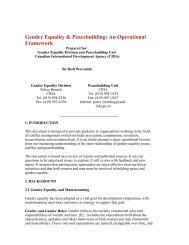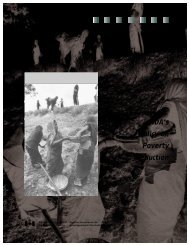Concepts and practices in agricultural extension in developing ...
Concepts and practices in agricultural extension in developing ...
Concepts and practices in agricultural extension in developing ...
- No tags were found...
You also want an ePaper? Increase the reach of your titles
YUMPU automatically turns print PDFs into web optimized ePapers that Google loves.
<strong>in</strong>terconnections constitute the wider webs of <strong>in</strong>teraction which structure social life <strong>in</strong> discourses,<strong>in</strong> work, <strong>and</strong> <strong>in</strong> the organizational <strong>and</strong> <strong>in</strong>terpersonal relationships <strong>in</strong> which relations of power areexercised (Sohng 1995).Action research typically <strong>in</strong>volves an <strong>in</strong>tervention methodology. As its eventual function is to br<strong>in</strong>gabout future change, <strong>in</strong> the short term, its key function is to <strong>in</strong>volve those who are most affected by theexpected change <strong>in</strong> a way that secures their commitment. Action research is typically cyclic. Carr <strong>and</strong>Kemmis (1986) conceive of each action research cycle as compris<strong>in</strong>g plann<strong>in</strong>g, action, observation <strong>and</strong>reflection, whilst Susman (1983) dist<strong>in</strong>guished five phases of action research as shown <strong>in</strong> Figure 1.1.Adapted from Susman (1983).Figure 1.1. Action Research Cycle.Firstly, a problem is identified <strong>and</strong> data is collected for detailed diagnosis. This is followed by acollective postulation of several possible solutions, from which a s<strong>in</strong>gle plan of action emerges <strong>and</strong>is implemented. At this po<strong>in</strong>t the best <strong>practices</strong> literature constitutes a useful <strong>in</strong>put <strong>in</strong>to this researchcycle, by provid<strong>in</strong>g promis<strong>in</strong>g, alternative courses of action. Data on the results of the <strong>in</strong>tervention arecollected <strong>and</strong> analysed, <strong>and</strong> the f<strong>in</strong>d<strong>in</strong>gs are <strong>in</strong>terpreted <strong>in</strong> light of how successful the action has been.At this po<strong>in</strong>t, the problem is reassessed <strong>and</strong> the process beg<strong>in</strong>s another cycle. This process cont<strong>in</strong>uesuntil the problem is solved.Action research is used <strong>in</strong> real situations, rather than <strong>in</strong> contrived, experimental studies, s<strong>in</strong>ce its primaryfocus is on solv<strong>in</strong>g real problems. It can, however, be used by social scientists for prelim<strong>in</strong>ary or pilotresearch, especially when the situation is too ambiguous to frame a precise research question. Mostly,<strong>in</strong> accordance with its pr<strong>in</strong>ciples, it is chosen when circumstances require flexibility, the <strong>in</strong>volvementof the people <strong>in</strong> the research, or change must take place quickly or holistically. It is often the case thatthose who apply this approach are practitioners who wish to improve underst<strong>and</strong><strong>in</strong>g of their practice,social change activists try<strong>in</strong>g to mount an action campaign, or, more likely, academics who have been<strong>in</strong>vited <strong>in</strong>to an organization (or other doma<strong>in</strong>) by decision-makers aware of a problem requir<strong>in</strong>g actionresearch, but lack<strong>in</strong>g the requisite methodological knowledge to deal with it.11





